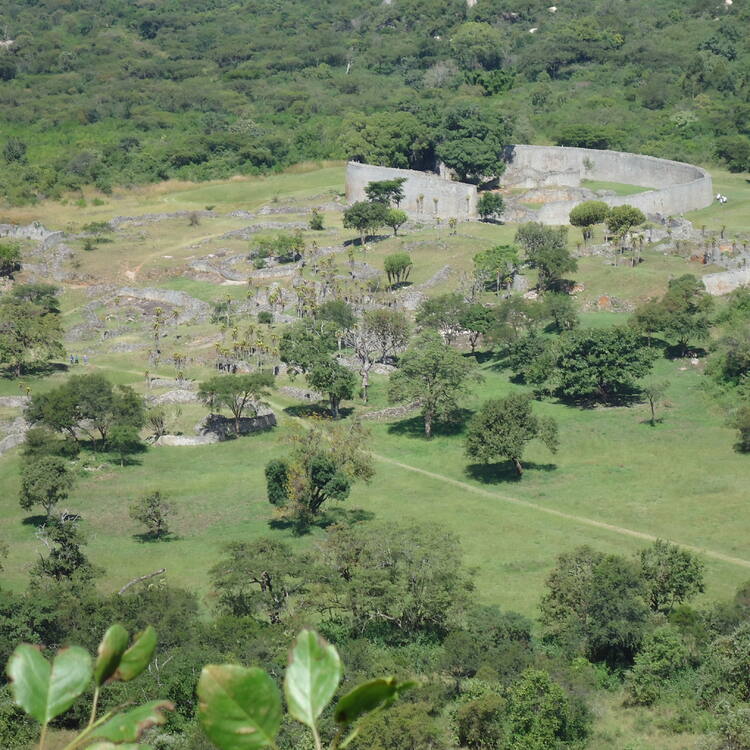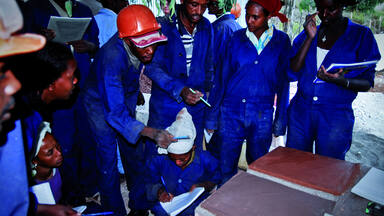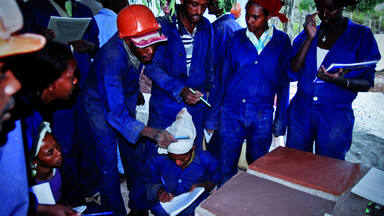Great Zimbabwe National Monument
Great Zimbabwe National Monument
The ruins of Great Zimbabwe – the capital of the Queen of Sheba, according to an age-old legend – are a unique testimony to the Bantu civilization of the Shona between the 11th and 15th centuries. The city, which covers an area of nearly 80 ha, was an important trading centre and was renowned from the Middle Ages onwards.
Description is available under license CC-BY-SA IGO 3.0
Monument national du Grand Zimbabwe
Les ruines du Grand Zimbabwe, qui, selon une légende séculaire, aurait été la capitale de la reine de Saba, sont un témoignage unique de la civilisation bantoue des Shona entre le XIe et le XVe siècle. La ville, d'une superficie de près de 80 ha fut un centre d'échanges important, renommé dès le Moyen Âge.
Description is available under license CC-BY-SA IGO 3.0
نصب زيمبابوي الكبرى الوطني
تشكل انقاض زيمبابوي الكبرى التي كانت بحسب إحدى الأساطير العلمانية عاصمة ملكة سبأ شاهداً فريداً على حضارة البانتو الخاصة بقبائل شونا بين القرنين الحادي عشر والخامس عشر. وأصبحت المدينة الممتدة على مساحة تقارب 80 هكتاراً مركزاً هاماً للتبادل ذاعت شهرته منذ القرون الوسطى.
source: UNESCO/CPE
Description is available under license CC-BY-SA IGO 3.0
大津巴布韦国家纪念地
据一个古老的传说,大津巴布韦遗址是希巴皇后的首府,同时还是11世纪到15世纪期间绍纳城班图文明唯一的见证。这座城市面积将近80公顷,曾经是一个重要的贸易中心,自中世纪以来闻名于世。
source: UNESCO/CPE
Description is available under license CC-BY-SA IGO 3.0
Национальный памятник Великий Зимбабве
Руины Великого Зимбабве, который, согласно древней легенде, был столицей царицы Савской, являются уникальными свидетельствами существования бантуязычной народности шона в период ХI-ХV вв. Этот город площадью около 80 га являлся важнейшим центром торговли и пользовался известностью с начала Средних веков.
source: UNESCO/CPE
Description is available under license CC-BY-SA IGO 3.0
Monumento nacional del Gran Zimbabwe
Las ruinas del Gran Zimbabwe –capital de la reina de Saba, según una vieja leyenda– son un testimonio excepcional de lo que fue la civilización bantú de los shona entre los siglos XI y XV. La ciudad, que abarcaba una superficie de unas 80 hectáreas, fue un importante centro de intercambios comerciales, muy conocido desde la Edad Media.
source: UNESCO/CPE
Description is available under license CC-BY-SA IGO 3.0
大ジンバブエ国立記念物
ジンバブエ南部、11~15世紀にかけて栄えた東アフリカ文化を伝える巨大な石造建築遺跡。丘の上の「アクロポリス」と、「谷の遺跡」と呼ばれる住居跡、低地に外壁をめぐらせた「神殿」の三つの遺跡に分かれている。「アクロポリス」は巨大な自然石を利用した石壁がつくられ、「神殿」には長径100m、短径80mの楕円形の建物である。source: NFUAJ
Nationaal monument Groot Zimbabwe
Het Nationaal monument Groot Zimbabwe ligt op 30 km van Masvingo (voorheen Fort Victoria). Het gebied strekt zich uit over bijna 800 hectare en is verdeeld in de Hill ruins (heuvelruïnes), Great Enclosure (grote omheining) en de Valley ruins (valleiruïnes). De indrukwekkende ruïnes getuigen op een unieke manier van de Bantoebeschaving van de Shona zoals die was tussen de 11e en 15e eeuw. Volgens een eeuwenoude legende is Groot-Zimbabwe de hoofdstad van de koningin van Sheba. De stad - met een oppervlakte van bijna 80 hectare - was een belangrijk handelscentrum en gerenommeerd sinds de Middeleeuwen en daarna.
Source: unesco.nl
Outstanding Universal Value
Brief synthesis
Great Zimbabwe National Monument is approximately 30 km from Masvingo and located in the lowveld at an altitude of some 1100 m in a sparsely populated region of the Bantu/Shona people. The property, built between 1100 and 1450 AD, extends over almost 800 ha and is divided into three groups: the Hill Ruins, the Great Enclosure and the Valley Ruins.
The Hill Ruins, forming a huge granite mass atop a spur facing north-east/south-west, were continuously inhabited from the 11th to 15th centuries, and there are numerous layers of traces of human settlements. Rough granite rubble-stone blocks form distinct enclosures, accessed by narrow, partly covered, passageways. This acropolis is generally considered a 'royal city'; the west enclosure is thought to have been the residence of successive chiefs and the east enclosure, where six steatite upright posts topped with birds were found, considered to serve a ritual purpose.
The Great Enclosure, which has the form of an ellipsis, is located to the south of the hills and dates to the 14th century. It was built of cut granite blocks, laid in regular courses, and contains a series of daga-hut living quarters, a community area, and a narrow passage leading to a high conical tower. The bricks (daga) were made from a mixture of granitic sand and clay. Huts were built within the stone enclosure walls; inside each community area other walls mark off each family's area, generally comprising a kitchen, two living huts and a court.
The Valley Ruins are a series of living ensembles scattered throughout the valley which date to the 19th century. Each ensemble has similar characteristics: many constructions are in brick (huts, indoor flooring and benches, holders for recipients, basins, etc.) and dry stone masonry walls provide insulation for each ensemble. Resembling later developments of the Stone Age, the building work was carried out to a high standard of craftsmanship, incorporating an impressive display of chevron and chequered wall decorations.
Scientific research has proved that Great Zimbabwe was founded in the 11th century on a site which had been sparsely inhabited in the prehistoric period, by a Bantu population of the Iron Age, the Shona. In the 14th century, it was the principal city of a major state extending over the gold-rich plateaux; its population exceeded 10,000 inhabitants. About 1450, the capital was abandoned because the hinterland could no longer furnish food for the overpopulated city and because of deforestation. The resulting migration benefited Khami, which became the most influential city in the region, but signaled waning political power. When in 1505 the Portuguese settled in Sofala, the region was divided between the rival powers of the kingdoms of Torwa and Mwene-Mutapa.
Archaeological excavations have revealed glass beads and porcelain from China and Persia, and gold and Arab coins from Kilwa which testify to the extent of long-standing trade with the outer world. Other evidence, including potsherds and ironware, gives a further insight to the property’s socio-economic complexity and about farming and pastoral activities. A monumental granite cross, located at a traditionally revered and sacred spiritual site, also illustrates community contact with missionaries.
Criterion (i): A unique artistic achievement, this great city has struck the imagination of African and European travellers since the Middle Ages, as evidenced by the persistent legends which attribute to it a Biblical origin.
Criterion (iii): The ruins of Great Zimbabwe bear a unique testimony to the lost civilisation of the Shona between the 11th and 15th centuries.
Criterion (vi): The entire Zimbabwe nation has identified with this historically symbolic ensemble and has adopted as its emblem the steatite bird, which may have been a royal totem.
Integrity
The property, extending to almost 800 ha, is considered relatively intact and of an appropriate size to maintain the diverse cultural needs, functions and interactions of the traditional and urban communities in an ongoing process. The boundaries and buffer zone have been delineated and are of sufficient size to contain the natural and aesthetic attributes of the property. It is well protected from modern environmental pressures and alternative land uses by surrounding cultural and traditional barriers, and by the traditional communities themselves.
The natural environment within and around the Great Zimbabwe Estate is important for the survival of the archaeological remains and the understanding of the relationship between the built environment and its setting. Measures need to be continued so that this important attribute continues to be protected. The natural fauna has to a large extent been eliminated by poaching and other means. Although the flora is not much different from the surrounding areas, it needs to be kept under control, particularly from the invasive lantana camara.
Authenticity
The authenticity of the property is unquestionable, particularly the fossil localities which need to remain undisturbed. It is a non-functional sacred archaeological site that is still being used by contemporary communities for spiritual reasons.
The method of construction is unique in African architecture and, although they are examples of similar work elsewhere, none are as distinguished and imposing as Great Zimbabwe. It is an edifice which emulates that of the prehistoric people and is unquestionably of Bantu origin. The Shona word Zimbabwe means the house in stone. The divine soapstone figurines, the Zimbabwe Birds, found within the ruins are testimony to the use of the site as place of worship spanning from the ancient past to the present day.
Decay phenomena have occurred due to variations in temperature, soil moisture content, and tourism pressure, encroaching invasive vegetation and improper preservation methods. All of these factors need to be controlled through a sustained conservation and maintenance plan to maintain the conditions of authenticity. Particular attention needs to be put on the conservation techniques and materials employed as well as on the application of conservation standards that meet international requirements but are balanced with traditional uses at the property. Provisions should also be made to accommodate rituals and practices that substantiate the associative values of the property.
Protection and management requirements
The site has been legally protected since 1893 and is currently protected under the National Museum & Monuments Act Chapter 25:11 (1976) which provides for the legal protection of the resources within the property.
The National Museums and Monuments of Zimbabwe (NMMZ), under the Ministry of Home Affairs, is the entity directly responsible for the management of the property. Funding for the management and conservation of the property comes mainly from the central government with limited income generated by entrance fees, accommodation and sale of publications which are used to finance projects at the national level at the discretion of the NMMZ Board of Trustees.
Although there are management arrangements for the property, an updated and integrated Management Plan is critical to ensure the long term conservation of the property and address existing factors mainly potential encroachments, impacts from unplanned or inappropriate tourism development and public use. Adequate financial resources need to be provided to ensure the sustained implementation of conservation, maintenance and monitoring activities and skilled staff needs to exist to mitigate the progressive deterioration of the historic fabric. The Management Plan should also emphasize the implementation of programmes to enhance community participation and promote the continuation of the religious functions of the site.



